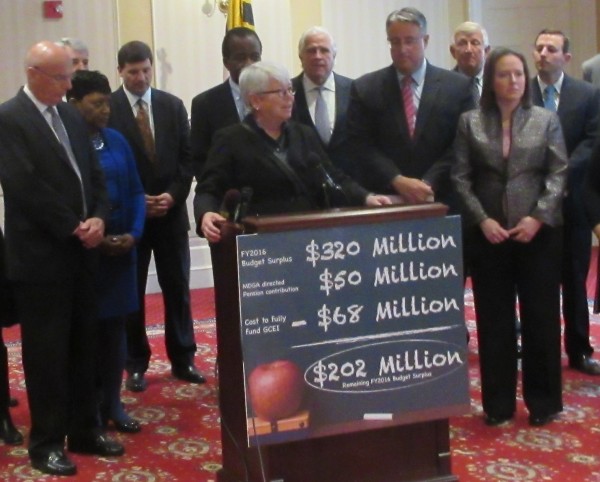By Barry Rascovar
For MarylandReporter.com
When Democratic legislators announced last week that a huge budget surplus would make it possible for Republican Gov. Larry Hogan, Jr. to reverse his earlier decision to cut $68 million in school aid, it was the equivalent of beating a dead horse to death.
(That’s an idiom occasionally used by unlettered Maryland politicians.)
Asking a politician of the opposite party to recant his prior action is a waste of time and energy. It’s not going to happen.
Democrats are doing it only to gain propaganda points. “Look! See! Larry Hogan is such a meanie he won’t use surplus funds to educate our children!”
Instead of trying to embarrass the governor, Democrats should have suggested practical ways for Hogan to spend this money wisely. That, at least, would be within the realm of possibilities.
Big bucks?
The surplus could top $700 million. That sounds like a lot of money but it is a one-time happening. It can’t support a major tax cut, or any other tax reduction – Hogan’s prime objective.
It would be a horrific mistake if Hogan sought tax relief based on a one-year surplus.
Maryland’s budget is precariously balanced. Another dip in the nation’s economy would send the state back into the red.
Sharply reducing taxes on the basis of one good fiscal year isn’t sound fiscal policy.
So how should the governor spend this extra cash?
Thoughtful Democrats and Republicans understand these one-time dollars are best used to pay for one-time spending projects – primarily purchases of badly needed equipment and construction projects.
Bonds, bonds, bonds
Maryland has a long-range financial crisis because the state overspent over the past 15 years by issuing too many construction bonds. Under Governors Bob Ehrlich and Martin O’Malley, the amount of new bonds issued each year jumped from $400 million to $1 billion.
Each of those bonds must be paid off, with interest, over 15 years. The compounding effect of issuing more and more bonds each year is staggering.
Two years from now, Maryland will max out its bonding capacity. Meanwhile, state taxpayers are spending in excess of $1.1 billion this fiscal year to pay the principal and interest on that growing mountain of bonds.
Hogan has a rare opportunity to make significant headway in turning around this out-of-control borrowing situation.
He might, for instance, use most of that surplus on a giant pay-as-you-go school construction program instead of issuing bonds. Thus, he’d be using only surplus dollars to fund Maryland’s school-building efforts.
And if he’s smart, he’d also use surplus dollars on another important school need: air-conditioning every single classroom in Maryland. It is shocking how many classrooms statewide lack even a window air-conditioner, not to mention central A/C.
Fewer IOUs
By using cash for these projects, Hogan would lower Maryland’s future bond obligations and the state’s future interest payments. A $400 million pay-go program for school buildings (including an A/C funding provision) would be a bold and sensible way to get a major fiscal problem under control.
Hogan also could use a portion of the state’s one-time surplus for other important construction activities.
He has the chance to set up a win-win situation at the old Bethlehem Steel plant at Sparrows Point by dedicating surplus dollars to bridge and interstate access improvements.
Those would be critical steps in jump-starting what could become Maryland’s largest and potentially most successful economic development initiative.
Additionally, the state’s current surplus could let Hogan set aside a substantial pot of funds to accelerate Baltimore’s vacant housing demolition program and help build safe, green neighborhoods in Maryland’s most troubled and largest city.
Democrats were foolish to try to politicize the announcement of a large state surplus. They sought to create conflict instead of an atmosphere of cooperation and mutual decision-making.
Hogan is right to ignore this transparent political ploy.
Instead, he should distribute those surplus dollars to one-time projects that are fiscally conservative and beneficial in the long run for Maryland.
Barry Rascovar’s blog is www.politicalmaryland.com. He can be reached atbrascovar@hotmail.com






We heavily fund our schools and the achievement gap keeps growing. Fully funding GCEI will make no appreciable difference. We have many more pressing needs. Education establishment panderers – enough is enough.
Can somebody explain how the $68 million that would go towards fully funding GCEI isn’t one time funding? Because of a bill passed in the 11th hour last session, the governor will be required to fully fund GCEI in future years regardless of what he does now, so I don’t see how spending that $68 million increases expenditures in the long term, which seems to be what the administration is arguing.
You and Barry are both talking about one-time expenditures, but GCEI doesn’t have the multiplier effect that Barry’s ideas have. Paying cash now would have tangible savings for future year budgets, freeing up more money for education and the rest of the budget; Sparrows Point to make it more attractive for business development and jobs. Remember, we still have a “structural deficit” even in the midst of a healthy surplus.